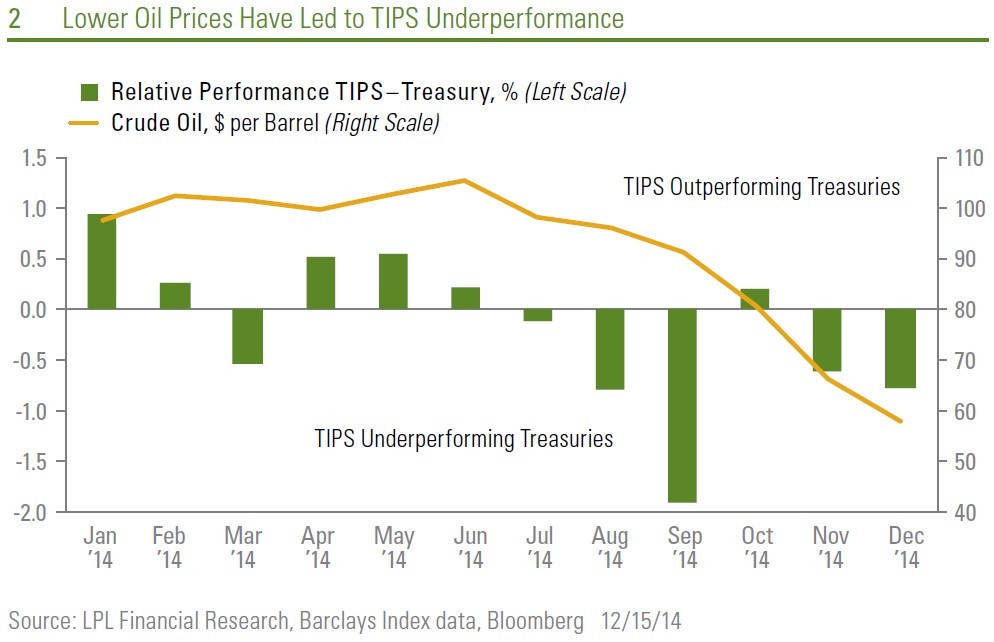How to Use TIPS to Calculate Inflation Expectations
Post on: 16 Март, 2015 No Comment

You can opt-out at any time.
Treasury Inflation-Protected Securities (TIPS) be used to calculate inflation expectations using some very simple math, but with the caveat that the result does not provide an exact measure.
TIPS: A Review
First, some background. Like a plain-vanilla Treasury note. TIPS provide investors with fixed-rate yield with interest paid semi-annually. The key difference: the principal is adjusted to reflect the change in the Consumer Price Index (CPI), and the interest payment is then calculated using the adjusted value of the bond. This payment increases with inflation, but it would decrease in the rare case of deflation (i.e. falling prices). The amount of principal an investor receives is their original investment or the investment plus the upward adjustment. In short, the principal rises with the CPI, while the coupon rate represents the investor’s “real return,” or return above inflation.
In comparison, plain-vanilla Treasuries carry no such inflation protection. Since the investor is fully exposed to the impact of inflation on the underlying bond, he or she demands a premium – which can be thought of as “protection” – to own Treasuries rather than TIPS.
Calculating Inflation Expectations
This premium can be calculated by comparing the difference in yields on a Treasury and a TIP of similar maturity. The result indicates the amount of protection investors require, which in turn tells us their inflation expectations. For example, if the five-year Treasury has a yield of 3% and the five-year TIPS has a yield of 1%, then inflation expectations for the next five years are roughly 2% per year. Similarly, using two- or ten-year issues would tell us the expectation for those periods. This difference is often referred to as the “breakeven” inflation rate.
Another way to look at the equation is: Treasury yield = TIPS yield + expected inflation.
We can therefore easily find the market’s expectation for the future inflation rate, in theory. The reason this is only “in theory” is because the differences between the two securities lead to market distortions that prevent this calculation from providing an exact result. TIPS’ trading volume is much lower than Treasuries’, so the yield differential can often change due to technical factors not having to do with inflation expectations. As a result, the yield gap can be used as a guide but not an absolute measure of current expectations.
Four ETFs Track Inflation Expectations
Investors can actually trade inflation expectations, since four exchange-traded funds (ETFs) track the gap between 10-year Treasuries and 10-year TIPS:
- ProShares 30 Year TIPS/TSY Spread (RINF). Tracks the TIPS-Treasury spread with no leverage. The share price of this fund should rise when expectations go up.
- ProShares Short 30 Year TIPS/TSY Spread (FINF). Tracks the inverse of the TIPS-Treasury spread with no leverage. This fund rises when inflation expectations fall.
- UltraPro 10 Year TIPS/TSY Spread (UINF). Tracks the TIPS-Treasury spread with three-times leverage. The share price of this fund should rise three times more than the spread.
- UltraPro Short 10 Year TIPS/TSY Spread (SINF). Tracks the inverse of the TIPS-Treasury spread with three-times leverage. The share price of this fund should rise three times the inverse of the spread.
Disclaimer. The information on this site is provided for discussion purposes only, and should not be construed as investment advice. Under no circumstances does this information represent a recommendation to buy or sell securities. Talk to a financial advisor and tax professional before you invest.














